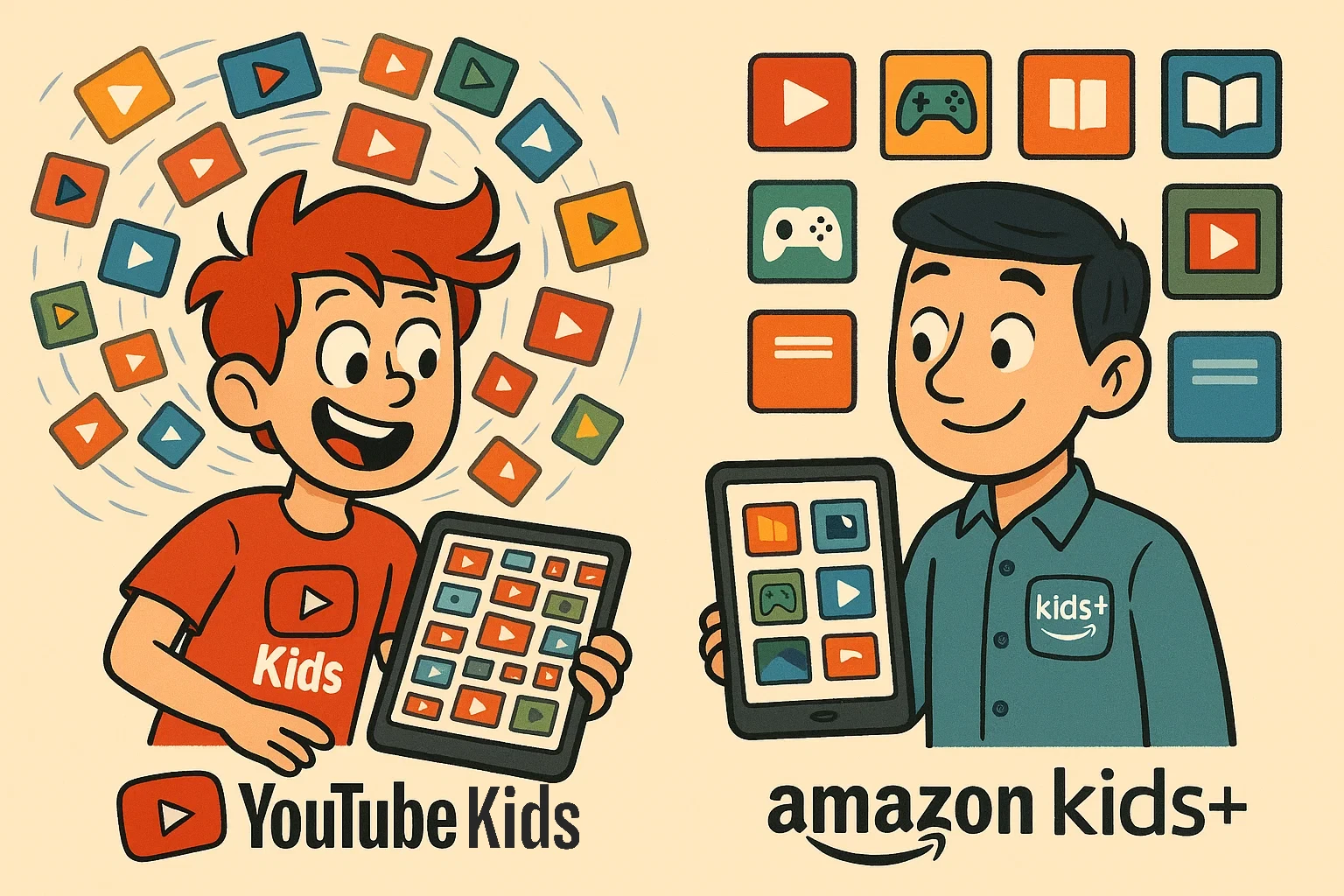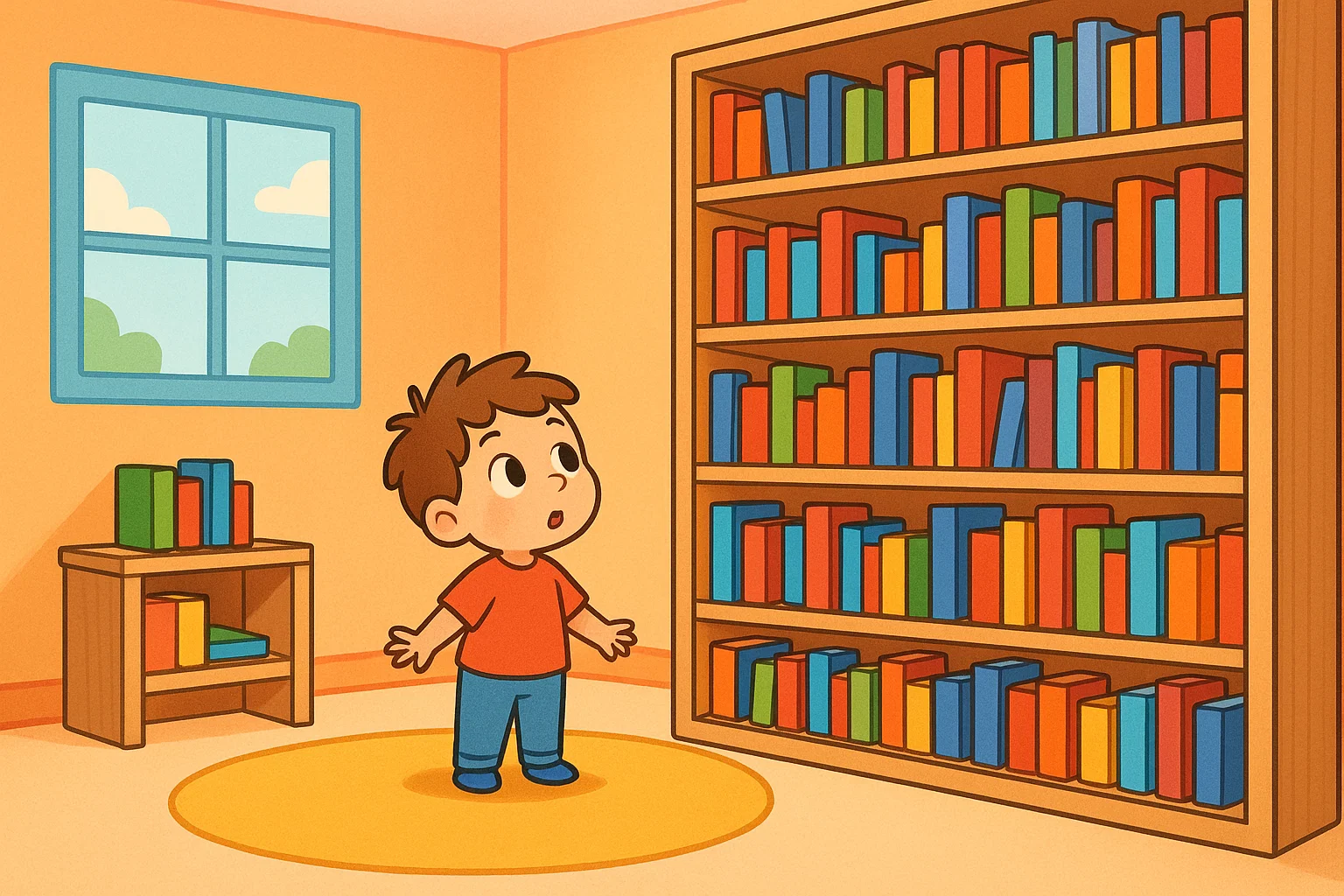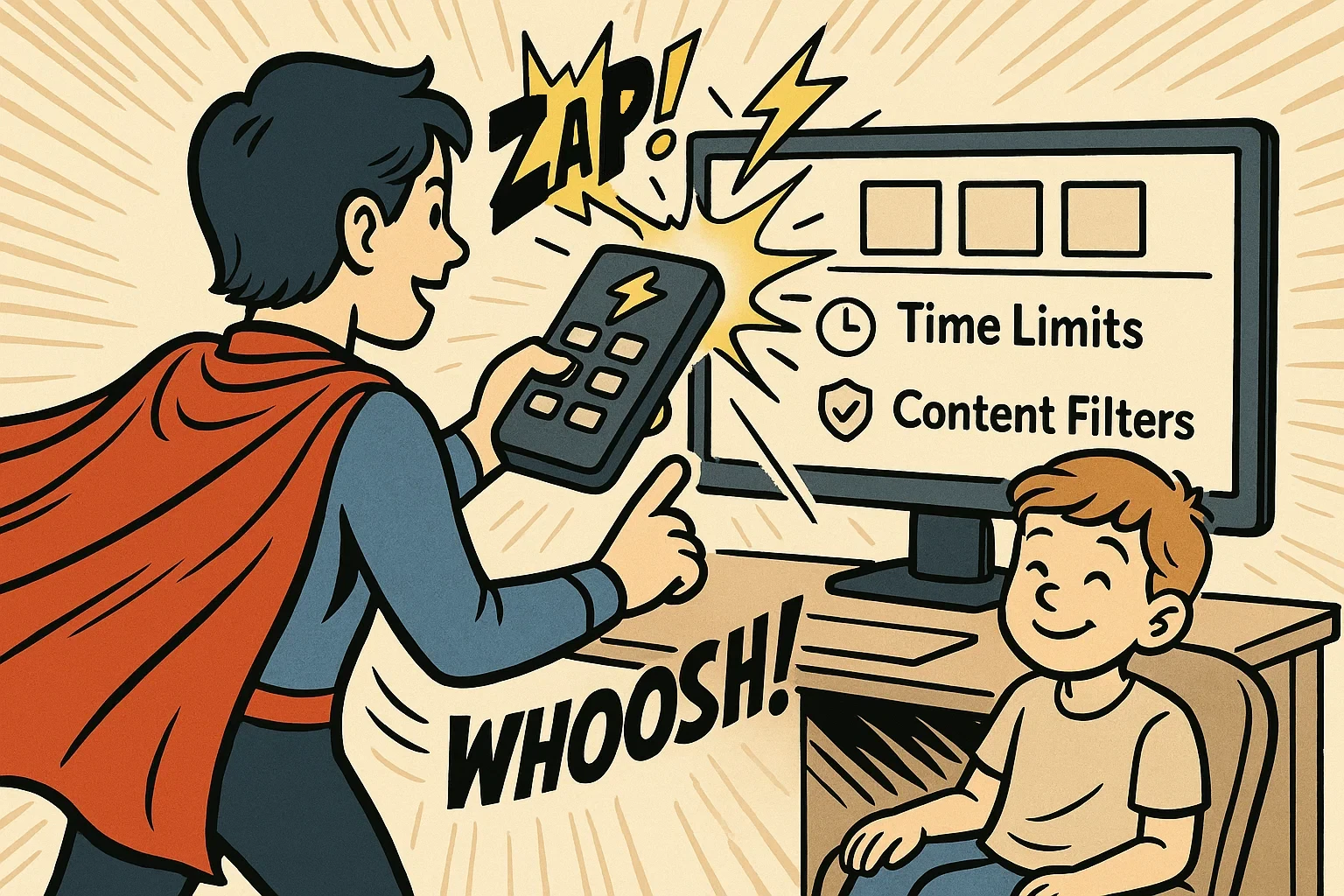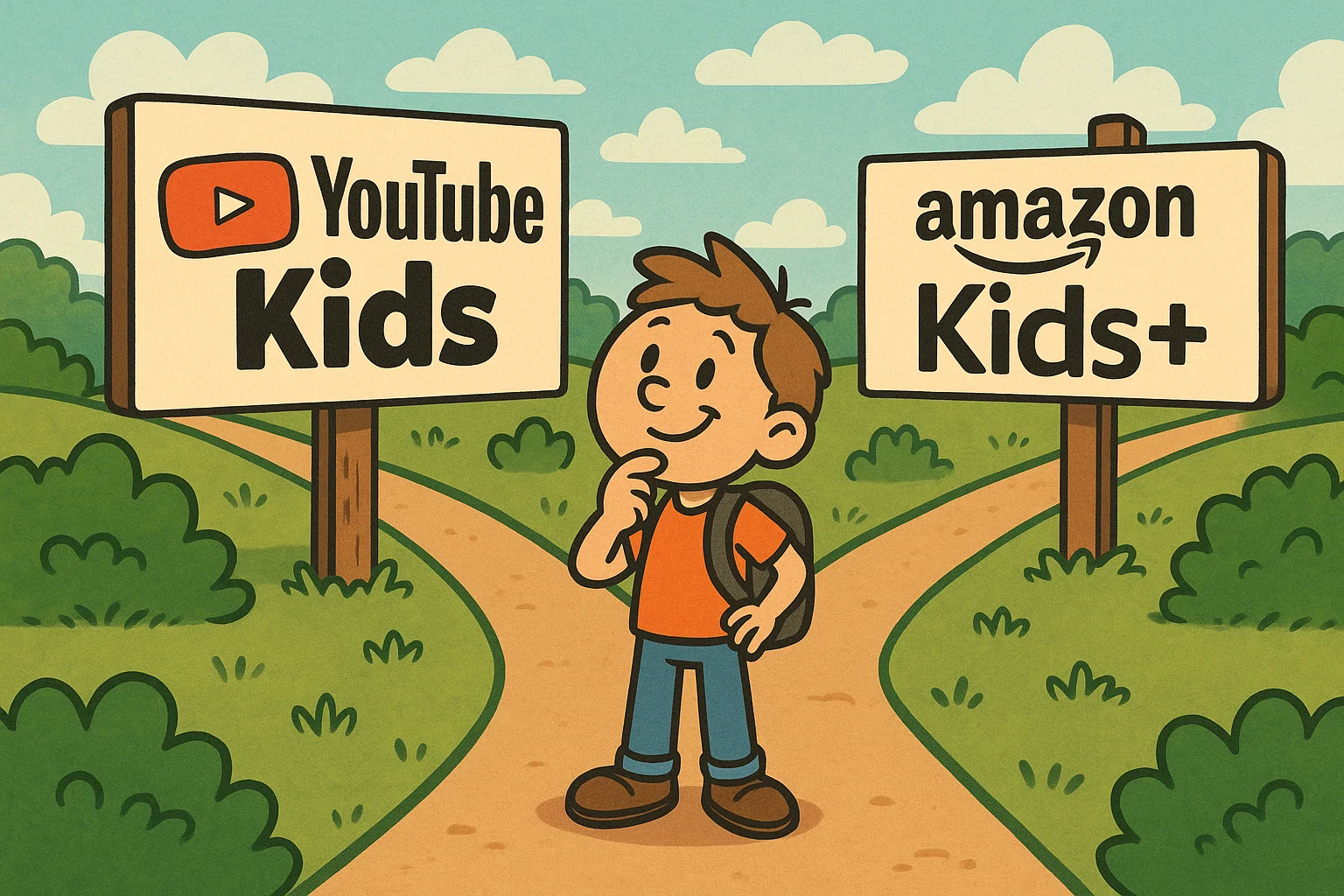YouTube Kids vs Amazon Kids+ Comparison Guide

As a parent in today’s digital landscape, choosing the right entertainment platform for your child can feel overwhelming. With screen time becoming an integral part of childhood, you need a service that balances fun with safety, education with entertainment. Two platforms consistently rise to the top of parents’ consideration lists: YouTube Kids and Amazon Kids+. But which one truly serves your family’s needs better?
This comprehensive comparison will help you navigate the key differences between these platforms, examining everything from content quality to parental controls, so you can make an informed decision for your child’s digital experience.
Platform Basics
YouTube Kids overview: What is YouTube Kids?
The platform operates on a simple premise: take the vast YouTube library and make it accessible to young viewers through age-appropriate filtering. Children can explore educational video, music videos, toy unboxings, and animated shows, all within a controlled environment designed specifically for their developmental needs.
What sets YouTube Kids apart is its foundation on user-generated video. Unlike traditional children’s programming, much of what children watch comes from independent creators, family channels, and educational organizations who upload content specifically targeting young audiences.
Amazon Kids+ overview: What is Amazon Kids+?
Amazon Kids+ (formerly FreeTime Unlimited) takes a distinctly different approach to children’s digital content. Rather than filtering existing video, Amazon has curated a premium library featuring content from established brands like Disney, Nickelodeon, PBS Kids, and National Geographic.
This subscription-based platform extends beyond just video content, incorporating books, games, and educational apps into a comprehensive digital ecosystem. Amazon has invested heavily in original programming, creating shows specifically designed to align with early childhood education principles and developmental milestones.
The platform emphasizes quality over quantity, with each piece of content undergoing rigorous review before inclusion. Parents often appreciate this curated approach, as it reduces the uncertainty that can come with user-generated platforms.
Audience age range: Target audience for each platform
Both platforms serve children, but their age targeting reveals important differences in video philosophy and design approach.
YouTube Kids officially targets children ages 4-12, though the platform offers two distinct experiences:
- Younger kids (ages 4-8): Features simplified navigation, larger buttons, and video focused on basic learning concepts
- Older kids (ages 9-12): Includes more complex video, educational videos about science and history, and age-appropriate entertainment
Amazon Kids+ casts a wider net, serving children from ages 3-12 with more granular age divisions:
- Ages 3-5: Emphasizes foundational learning, simple stories, and basic educational games
- Ages 6-8: Introduces more complex narratives and intermediate educational content
- Ages 9-12: Features advanced educational materials and age-appropriate entertainment content
The age range differences reflect each platform’s content strategy, with Amazon Kids+ offering more structured, curriculum-aligned content for younger children, while YouTube Kids provides greater variety for slightly older kids who can navigate more independently.
Availability on devices: Where to access each service
Device compatibility can significantly impact your family’s viewing experience and convenience.
| Platform | Mobile Apps | Smart TVs | Gaming Consoles | Web Browser | Tablets |
| YouTube Kids | iOS, Android | Most smart TV platforms | Limited | Yes | Yes |
| Amazon Kids+ | iOS, Android | Fire TV, some others | Fire devices | Limited | Yes |
YouTube Kids offers broader device compatibility, available on most smartphones, tablets, smart TVs, and through web browsers. This extensive availability makes it convenient for families who use various devices throughout their home.
Amazon Kids+ shows stronger integration within Amazon’s ecosystem, working seamlessly on Fire tablets, Fire TV devices, and Echo Show devices. However, it may have limitations on non-Amazon smart TV platforms and gaming consoles.
Content Library

Video selection: Quantity and variety of videos 📹
The video approach between these platforms reveals fundamentally different philosophies about children’s media consumption.
YouTube Kids leverages the massive YouTube ecosystem, potentially offering millions of videos across countless topics. Children can discover content about dinosaurs, space exploration, art tutorials, music, and virtually any topic that sparks their curiosity. This vast selection means children rarely exhaust available content, and new videos appear regularly as creators upload fresh material.
Amazon Kids+ takes the opposite approach, offering thousands rather than millions of videos, but each undergoes careful curation. The platform features content from trusted brands like Sesame Street, Daniel Tiger’s Neighborhood, and Amazon’s original programming. While the selection is smaller, parents often appreciate the consistent quality and educational value.
The curated approach means children are less likely to encounter low-quality content, but they may exhaust interesting options more quickly, especially if they have specific interests not well-represented in the library.
Learning resources: Educational content available 🎓
YouTube Kids educational content ranges from excellent to questionable. High-quality educational channels like Crash Course Kids, National Geographic Kids, and SciShow Kids offer professionally produced content that rivals traditional educational television. Children can explore advanced topics like coding, foreign languages, and complex scientific concepts through engaging video formats.
Amazon Kids+ integrates education more systematically, often aligning content with Common Core standards and early childhood development principles. Shows like “Elinor Wonders Why” teach scientific thinking, while “Creative Galaxy” explores art concepts. The platform’s educational approach tends to be more structured and curriculum-focused.
Ad experience: Presence of advertisements
The advertising experience significantly differs between these platforms and can impact both user experience and family values.
YouTube Kids includes advertisements, though they’re filtered for age-appropriateness. Ads typically promote toys, games, or family-friendly products. However, some parents express concerns about advertising’s impact on young children, particularly around toy commercials that may increase purchase requests.
The platform does offer some ad controls, allowing parents to pause advertising or limit certain types of promotional videos. However, advertising remains integral to YouTube’s free business model.
Amazon Kids+ provides an ad-free experience for subscribers, which many parents appreciate. Children can watch content without interruption or exposure to commercial messaging. This ad-free environment may create a more focused viewing experience and reduce parent-child conflicts around advertised products.
The absence of advertising also means children spend more time consuming actual content rather than promotional material, potentially providing better value for viewing time.
Originals and exclusive content: Unique shows and videos
Original programming reveals each platform’s investment in creating distinctive, high-quality content for young audiences.
YouTube Kids doesn’t produce original video directly, but it features exclusive content from popular YouTube creators who focus on children’s programming. Channels like Blippi, Ryan’s World, and CoComelon create content exclusively or primarily for young audiences, often becoming household names among children.
These creator-driven originals can be highly engaging for children, as they often feature real people, interactive elements, and content that responds to trending interests among young viewers.
Amazon Kids+ has invested significantly in original programming, creating shows like “Pete the Cat,” “If You Give a Mouse a Cookie,” and “Tumble Leaf.” These productions often feature high production values, celebrity voice actors, and storylines developed specifically for the platform.
Amazon’s originals tend to focus heavily on educational outcomes, social-emotional learning, and character development, reflecting the company’s investment in child development research and curriculum alignment.
Parental Controls

Screen time limits: How to set time restrictions ⏰
Managing screen time remains a crucial concern for modern parents, and both platforms offer different approaches to time management.
YouTube Kids provides basic time limit functionality, allowing parents to set daily viewing limits or use a timer for individual sessions. When time expires, children receive a gentle notification, and the app becomes inaccessible until the next day or until parents manually reset the timer.
The platform also includes a “take a break” reminder feature, encouraging children to pause viewing at regular intervals. However, some parents find these controls less sophisticated than they’d prefer, particularly for managing multiple children with different time allowances.
Amazon Kids+ offers more comprehensive time management tools through its Parent Dashboard. Parents can set different time limits for weekdays versus weekends, establish bedtime hours when content becomes inaccessible, and create individual schedules for multiple children.
The platform also allows parents to set educational goals, requiring children to engage with educational content before accessing entertainment options. This “learning first” approach appeals to parents who want to ensure educational value alongside entertainment.
Content filters and management: Tools for content filtering
Content filtering capabilities can make or break a children’s platform for safety-conscious parents.
YouTube Kids offers several filtering options:
- Younger Kids Mode: Restricts content to preschool-appropriate material
- Older Kids Mode: Allows broader content suitable for school-age children
- Custom Mode: Enables parents to handpick specific channels and videos
- Blocking Options: Parents can block specific videos or entire channels if inappropriate content appears
The platform uses both automated systems and human reviewers to filter content, though some inappropriate material occasionally slips through due to the vast volume of content being uploaded continuously.
Amazon Kids+ employs a more restrictive, curated approach where content undergoes review before platform inclusion. Parents can further customize by:
- Age-based filtering that automatically adjusts as children grow
- Content type selection (videos, books, games, apps)
- Individual profile customization for multiple children
- Discussion guides for parents who want to engage with content themes
Parent dashboard features: Overview of control panel
Comprehensive parental dashboards help parents understand and manage their children’s digital consumption patterns.
YouTube Kids provides a relatively simple parent dashboard accessible through the adult’s Google account. Parents can view watch history, manage blocked content, and adjust basic settings. However, the analytics and insights are limited compared to more comprehensive family management platforms.
Amazon Kids+ offers a more robust Parent Dashboard featuring:
- Detailed viewing reports showing time spent on different content types
- Educational progress tracking
- Content recommendations based on child’s interests and learning goals
- Remote management capabilities for adjusting settings without accessing the child’s device
- Discussion prompts to help parents engage with content their children consume
User profiles for children: Creating individual profiles
Multi-child families particularly benefit from platforms that accommodate individual children’s needs and preferences.
YouTube Kids allows parents to create separate profiles for up to eight children, each with customized age settings, content preferences, and viewing history. However, profile management remains relatively basic, with limited customization options beyond age-appropriate filtering.
Amazon Kids+ excels in profile management, offering detailed customization for each child including:
- Individual educational goals and progress tracking
- Personalized content recommendations based on interests
- Separate time limits and schedule restrictions
- Age-specific content that automatically updates as children grow
- Individual reward systems and achievement tracking
Cost Structure
Understanding the financial commitment helps families budget for children’s entertainment while evaluating value proposition.
YouTube Kids operates as a completely free platform, supported by age-appropriate advertising. Families can access all features, content, and parental controls without any subscription fees. This accessibility makes it attractive for families on tight budgets or those hesitant to commit to another monthly subscription.
The free model does mean accepting advertising and potentially less stringent content curation, but for many families, the cost savings outweigh these considerations.
Amazon Kids+ requires a monthly or annual subscription, with pricing that varies based on Amazon Prime membership status:
| Subscription Type | Monthly Cost | Annual Cost | Prime Member Discount |
| Individual Child | $4.99 | $48/year | $2.99/month |
| Family (up to 4 profiles) | $9.99 | $99/year | $6.99/month |
Prime members receive significant discounts, making Amazon Kids+ more affordable for families already invested in Amazon’s ecosystem. The family plan offers good value for households with multiple children, as individual profiles can be customized for each child’s age and interests.
User Interface
Child-friendly design: Visual appeal and layout
Visual design significantly impacts how engaging and accessible platforms feel to young users.
YouTube Kids employs bright, playful colors with rounded corners and friendly typography that appeals to children. The thumbnail-heavy design helps pre-readers navigate through visual cues, and the overall aesthetic feels familiar to children who may have experience with YouTube’s main platform.
Amazon Kids+ uses a more structured, educational-feeling design with clear visual hierarchies and consistent branding. The interface feels more like a digital library than a entertainment platform, which may appeal to education-focused families but could feel less exciting to children seeking pure entertainment.
App experience: Performance and usability
Technical performance affects daily usability and family satisfaction with these platforms.
YouTube Kids generally performs well across devices, with smooth video streaming and responsive navigation. However, performance can vary based on internet connection quality, and some parents report occasional glitches with content filtering or inappropriate recommendations appearing briefly.
Amazon Kids+ typically offers solid performance, particularly on Amazon devices where integration is optimized. The platform tends to have fewer technical issues but may experience slower content loading on non-Amazon devices or with slower internet connections.
Personalization options: Customizing child’s experience
Personalization helps platforms feel more relevant and engaging for individual children while supporting their developmental needs.
YouTube Kids offers basic personalization through viewing history and simple preference settings. The algorithm learns from viewing patterns to suggest similar content, though parents have limited control over how these recommendations develop.
Amazon Kids+ provides more sophisticated personalization, including:
- Interest-based video curation
- Educational goal setting and progress tracking
- Age-appropriate videos that evolve with the child
- Parental input on video preferences and restrictions
- Achievement systems that encourage educational engagement
Safety And Privacy
Data collection policies: How data is handled 🔐
Understanding how platforms handle children’s personal information is crucial for privacy-conscious families, especially given increasing awareness of digital privacy issues.
YouTube Kids operates under Google’s broader privacy policies, with some specific protections for children’s accounts. The platform collects viewing history, search queries, and device information to improve recommendations and functionality. Google has faced scrutiny over data practices, leading to policy updates and increased transparency about data collection from minors.
Parents should understand that viewing data may be used to improve Google’s algorithms and services, though the company states this information isn’t used for traditional advertising targeting for children’s accounts.
Amazon Kids+ follows Amazon’s privacy policies with additional protections for children’s accounts. The platform collects similar data for content recommendations and parental reporting but emphasizes that children’s personal information isn’t shared with third parties for advertising purposes.
Amazon’s integration across its ecosystem means data may be used to improve various Amazon services, though the company maintains that children’s data receives special protection and isn’t used for commercial targeting.
Advantages of YouTube Kids
YouTube Kids offers several compelling benefits that make it attractive to many families, particularly those seeking variety and accessibility in their children’s digital entertainment.
Cost accessibility stands as perhaps the platform’s most significant advantage. In an era where subscription services continue proliferating, YouTube Kids provides comprehensive children’s videos without adding another monthly expense to family budgets. This accessibility makes quality children’s programming available to families regardless of economic circumstances.
Content variety exceeds virtually any other children’s platform. Children can explore virtually unlimited topics, from detailed explanations of how airplanes work to creative art tutorials, foreign language lessons, or deep dives into historical events. This breadth supports children with diverse interests and learning styles who might not find relevant content on more curated platforms.
Creator diversity brings authentic voices and perspectives that traditional media sometimes lacks. Children can learn from educators of various backgrounds, see families that look like theirs, and explore cultural content that reflects their heritage or sparks curiosity about other cultures.
Regular content updates mean children always have fresh material to explore. Unlike traditional television or curated platforms where new video arrives on set schedules, YouTube Kids continuously receives new uploads from creators worldwide.
Educational depth can be exceptional when children discover high-quality educational channels. Platforms like Crash Course Kids or SciShow Kids offer content that rivals or exceeds traditional educational programming in both engagement and educational value.
Advantages of Amazon Kids+
Amazon Kids+ provides distinct benefits that appeal to families prioritizing curation, educational structure, and comprehensive digital experiences.
Content quality consistency represents a major advantage for busy parents who prefer not to pre-screen their children’s entertainment. Amazon’s curation process means parents can feel confident that content meets educational and appropriateness standards without constant supervision.
Ad-free experience eliminates interruptions and reduces commercial pressure on children. Parents often appreciate not having to explain why they can’t buy every toy featured in advertisements or dealing with increased purchase requests after viewing sessions.
Educational integration goes beyond entertainment, with many shows specifically designed to support learning objectives and childhood development goals. Content often includes discussion guides for parents who want to extend learning beyond screen time.
Multi-format content means children can seamlessly transition between videos, books, games, and educational apps within a single platform. This variety supports different learning styles and keeps children engaged without switching between multiple applications.
Comprehensive parental controls provide detailed insights into children’s consumption patterns and robust tools for managing screen time, content access, and educational goals. Parents appreciate the detailed reporting and remote management capabilities.
Brand reliability offers peace of mind through content from trusted sources like PBS Kids, Disney, and National Geographic. Parents familiar with these brands can anticipate content quality and educational value.
Final Verdict

| Feature | YouTube Kids | Amazon Kids+ |
| Cost | Free, ad-supported | Subscription fee required |
| Content Model | Filters from YouTube library (user-generated) | Curated, pre-screened library |
| Content Size | Millions of videos | Thousands of videos, books, apps |
| Ad Experience | Age-appropriate ads included | Ad-free for subscribers |
| Educational Focus | Varies, depends on creators | Structured, curriculum-aligned |
| Parental Controls | Basic time limits and filters | Comprehensive dashboard with detailed control |
| Device Availability | Broad on most platforms | Optimized for Amazon devices |
| Content Variety | Wide range of topics and creators | Limited to approved brands |
Which platform is better for your child?
The choice between YouTube Kids and Amazon Kids+ ultimately depends on your family’s specific needs, values, and circumstances rather than one platform being universally superior.
Choose YouTube Kids if:
- Budget constraints make subscription services impractical
- Your child has specific interests not well-represented in mainstream children’s programming
- You prefer maximum content variety and don’t mind more active parental curation
- Your family values diverse creator perspectives and authentic voices
- You’re comfortable with age-appropriate advertising
- Your child is older (8-12) and can navigate content choices independently
Choose Amazon Kids+ if:
- You prioritize consistent content quality over quantity
- Ad-free viewing is important to your family
- You want structured educational content aligned with learning objectives
- You appreciate comprehensive parental controls and detailed usage reporting
- Your family already subscribes to Amazon Prime
- You have younger children (3-7) who benefit from more curated content selection
- You want multi-format content (videos, books, games) in one platform
Consider your child’s personality: Some children thrive with unlimited options and discovery-based learning, while others feel overwhelmed by too many choices and benefit from curated, structured content experiences.
Hybrid approach: Many families find success using both platforms strategically – YouTube Kids for exploring specific interests and diverse content, Amazon Kids+ for structured learning time and guaranteed appropriate content.
The “better” choice is the one that aligns with your family’s values, supports your child’s developmental needs, and fits sustainably into your budget and lifestyle. Both platforms can provide valuable, safe entertainment and educational opportunities when used thoughtfully.
FAQ
Can I use both platforms simultaneously for my child?
Yes, many families successfully use both YouTube Kids and Amazon Kids+ to maximize benefits from each platform. You might use Amazon Kids+ for structured educational time and YouTube Kids for creative exploration and diverse video discovery. Just ensure screen time limits account for usage across both platforms to maintain healthy viewing habits.
How do I know if content is truly age-appropriate on either platform?
While both platforms work to ensure age-appropriate videos, parental oversight remains important. Start by watching videos with your child, regularly check viewing history through parental controls, and maintain open communication about what your child is watching. Report any inappropriate videos immediately, and consider creating approved playlists or channels for younger children.
Which platform works better for children with special learning needs?
This depends on your child’s specific needs. YouTube Kids offers more diverse videos that might address niche learning requirements, including specialized educational channels for different learning styles. Amazon Kids+ provides more structured, curriculum-aligned videos that some children with attention or processing differences find easier to follow. Consider trying both platforms to see which format better supports your child’s learning preferences.
